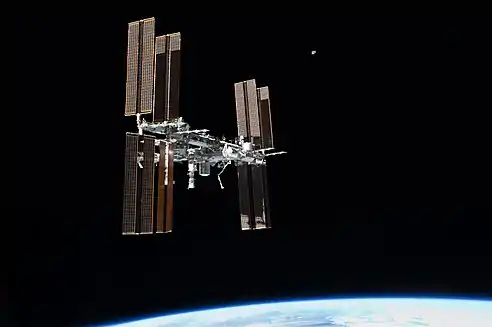Space Systems Engineering
Fundamentals, Technologies, and Projects for the 21st Century
Table of Contents

Photograph from the space shuttle Atlantis (STS-135) in its final fly-around of the International Space Station in July 19, 2011. Shows the ISS, Earth and moon.
Part 0: Introduction
Part 1: Science and Engineering Fundamentals
- Basic Sciences - Physics: Units, Motion, Forces || page 2: Energy, Mechanics, Thermodynamics || page 3: Astronomy, Planetary Science, Chemistry
- Orbital Mechanics - Orbits, Velocity Map, Powered Flight, Mass Ratio, Staging
- Propulsive Forces - Reaction from Expelled Material, External Interaction
- Energy Sources - Mechanical, Chemical, Thermal, Electrical, Beam, Nuclear, Matter Conversion
- Systems Engineering - In General, Life Cycle, Requirements || page 2: Functional Analysis, Allocation, Modeling, Optimization and Trade Studies, Synthesis, Work Breakdown Structure, Elements by Type
- Engineering Tools - Data, Computer Hardware, Computer Software
- Engineering Specialties - Aerospace, Other Specialties
- Organization and Economics - Organization, Funding, Financial Analysis
- Existing Programs - Government || page 2: Government (cont.), Commercial, Not-for-Profit
- Future Projects - Transport, Exploration, Mining, Industrial Capacity, Manufactured Items, Energy, Engineered Environments, Communication, Entertainment
Part 2: Transport Technologies
- Structural Methods - Static, Dynamic
- Guns and Accelerators - Mechanical, Artillery || page 2: Light Gas, Electric
- Combustion Engines - Air Breathing, Internally Fueled (Rockets)
- Thermal Engines - Electro-thermal, Photo-thermal, Nuclear-thermal
- Bulk Matter Engines - Rotary, Coilgun, Railgun
- Ion and Plasma Engines - Ion, Arcjet, Plasma
- High Energy Particle Engines - Particle Rockets, External Particle Interaction
- Photon Engines - Photon Sails, Photon Rockets, Photon Gun
- External Interaction Methods - Magnetic, Gravity, Aerodynamic, Mechanical
- Theoretical Methods - not currently supported by established physics
- Comparisons Among Methods - Performance, Status, Cost
Part 3: Engineering Technologies
- Design Factors - Technology, Availability, Physical, Integration, Human, Environment
- Subsystem Design
- Resources - Exploration Methods || page 2 - Resource Inventory
- Resource Extraction - Mining: Solid, Atmospheres, Liquids, Gas Giants, Particulates, Stars || Energy: Solar, Fission, Fusion, Orbital
- Processing and Fabrication - Production Control, Handling and Storage, Materials Processing, Parts Production
- Assembly and Construction - Assembly, Construction, Outfitting
- Verification and Test
- Operation and Maintenance - Operations Concepts, Tasks, Maintenance Concepts, Tasks
- Recycling Methods - Waste Recycling, Closed Loop Life Support
Part 4: Projects and Programs
- Program Overview - Goals, Summary, Structure
- Phase 0 - Research & Development - Planning, Process, Sub-Phases & Tasks
- Phases 1 to 3 For Earth - Locations: Starter, Network, Distributed, Industrial, Difficult, Extreme
- Phase 2B: Industrial Locations for Space - Survey, Drivers, Concept, Details || page 2 - Hypervelocity Launcher
- Phase 4A: Low Orbit Development - Features, Projects || page 2: Orbital Assembly
- Phase 4B: High Orbit Development - Features, Industries, Drivers, Projects, Integration, Details
- Phase 4C: Inner Interplanetary Development - System Concept, High Orbit Skyhook, Inclination Station, Transfer Habitats
- Phases 4D-F: - Main Belt & Trojan, Outer Interplanetary, Scattered, Hills, & Oort
- Phase 5A: Lunar Development - Features, Industry Survey, Drivers, Projects || page2 - Projects (cont.)
- Phase 5B: Mars Development - Near Term: Phobos and Deimos, Mars Skyhooks, Mars Surface Systems || Long Term Development: Magnetosphere, Greenhouses, Full Atmosphere
- Phases 5C-E - Venus & Mercury, Jupiter System, Outer Gas Giants
- Phase 6: Interstellar Development - Nearby Interstellar, Nearby Exostellar, Farther Interstellar
- Orbital Mining - Rationale, Mining Steps || page 2 - Ore Types, Example Missions, Design
- Processing Factory - Outputs, Process Research and Development, Factory Design
- Spaceport Network - Concept, Applications, Design Parameters, Design Components, Design Issues
Part 5: Design Studies
- Conceptual Design for Human Expansion - Goals and Benefits || page 2: Conceptual Design Approach || page 3: Requirements Analysis || page 4: Evaluation Criteria || page 5: Functional Analysis
- Environment Ranges
- Seed Factories - Conceptual designs for self-expanding automated factories (in separate wikibook).
- Open Source Space Program
References and Sources
This article is issued from Wikibooks. The text is licensed under Creative Commons - Attribution - Sharealike. Additional terms may apply for the media files.